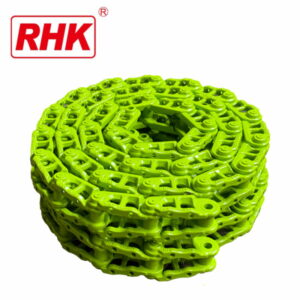Track links are designed to withstand significant wear from friction and abrasion, as they are constantly in contact with the ground and subjected to heavy loads and harsh operating conditions.
Here are some ways in which track links are designed to resist wear from friction and abrasion:
- Hardened Materials: Track links are typically made from hardened steel or other high-strength alloys that are resistant to abrasion and wear. These materials have excellent durability and can withstand the frictional forces exerted during operation.
- Surface Treatments: Track links may undergo surface treatments or coatings to enhance their resistance to wear. Common treatments include heat treatment, nitriding, carburizing, or induction hardening, which increase the surface hardness and toughness of the track links.
- Anti-Wear Features: Some track links incorporate anti-wear features such as hardened wear pads or inserts at critical contact points with the drive sprocket, idler wheels, and track rollers. These wear-resistant components help distribute the load more evenly and reduce localized wear.
- Optimized Geometry: The geometry of track links is optimized to minimize contact area and frictional forces with the ground while maintaining sufficient traction and stability. Curved or beveled edges, as well as chamfered surfaces, can help reduce friction and abrasion.
- Lubrication Systems: Many tracked vehicles are equipped with automatic or manual lubrication systems that deliver lubricants to the track links, Track Link suppliers pins, and bushings. Proper lubrication reduces friction and wear between moving components, prolonging the lifespan of the track links.
- Durable Connection Points: The connection points between track links, such as pins, bushings, and bolts, are designed to withstand wear and deformation under heavy loads and repetitive motion. These components are often made from hardened steel and may have wear-resistant coatings or surface treatments.
- Regular Maintenance: Regular inspection, cleaning, and maintenance of track links are essential to identify signs of wear and address them before they lead to more significant damage. Periodic replacement of worn or damaged track links is necessary to maintain optimal performance and safety.
- Track Shoe Design: The design of the track shoe, which is the part of the track link that makes contact with the ground, can also influence wear resistance. Some track shoes feature specialized tread patterns or materials that enhance traction and reduce abrasion.
By incorporating these design features and maintenance practices, track links can effectively resist wear from friction and abrasion, ensuring reliable performance and longevity in demanding operating environments.
